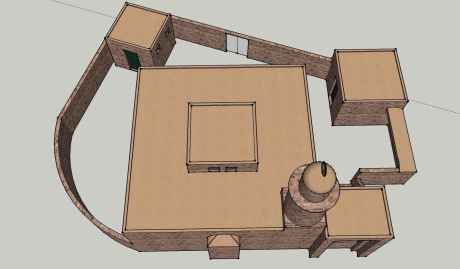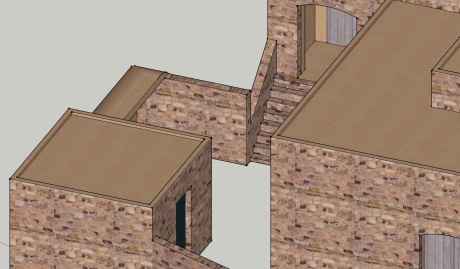Dana Mosque
16 March 2009
The Jordanian village of Dana, about 150 kilometers south of Amman, sits atop the edge of a plateau at the head of Wadi Dana, a valley that leads from the highlands into the Dead Sea rift valley. The valley descends from a height of 1,200 meters to 300 meters, with the village occupying a saddle of land at the top. The views down the valley are exceptional, and the village environs are irrigated by springs which drain down the valley; the upper reaches of the village are rich in orchards. The Royal Society for the Conservation of Nature manages the wadi as a nature reserve, and runs a renowned guesthouse in the old village, as well as an eco-lodge at the bottom of the wadi. In Khirbet Feynan at the base of the wadi can be found archaeological traces of some of the earliest copper mines in the world.
The village of Dana is one of the more intact of the traditional plateau villages, though other villages such as Shammakh to the south have a similar posture on the landscape. Villages of this type are found near the top of the plateau, as the land begins to slope into the rift, where the watershed meets the surface and springs allow irrigation. The architecture of the village structures consists of rough hewn stone squares with stone arches that span the width of the structure. The roof consists of reeds or branches placed across the arch tops and the exterior walls, sealed with soil, straw, and clay-like mud. The structures are close together, with narrow alleys, and infrequently exceed one story. They generally have a single doorway, and very few, if any, windows.
From the 60s on, the Jordanian government began extending services to the villages, however the terrain made infrastructure delivery difficult, and “new” districts for these plateau villages began to grow on the level top of the plateau, near major roads. Populations shifted rapidly to these new villages (the structures of which are almost exclusively inexpensive concrete block), leaving the traditional villages in disrepair. Ownership of these old village plots endures among the village families, but has become and will grow even more convoluted because of inheritance practices.
Dana, largely due to RSCN investment and tourist interest, has received considerable care, with a number of structures and the major village lanes renovated and rehabilitated. Among these structures is the village mosque, which has been restored and is a particularly beautiful example of traditional design.
I have modeled the mosque based on approximate measurements. Unfortunately, the model does not convey the immediate surroundings and terrain, which are important element of the overall architectural impact of the structure.

Perspective 1
In perspective 1, the main door level indicates the soil level, which slopes considerably. The qiblah niche is protruding from the wall. The minaret is stone, which contrasts with the corrugated metal used in newer mosques.

Perspective 2
Perspective 2 indicates the rear door, and a small storage structure to the right. The mosque has no windows into its main mass, but rather a set of clerestory windows at the roof level.

Perspective 3
This higher perspective gives an idea of the layout of the structure. The overhanging ledge on the righthand wall shelters the ablution area.

Perspective 4
The perspective focuses on the entry vestibule and interior courtyard area. Though the texture in the model is regularized, the actual stone is varied and rough.
The mosque is located at 30*40’30.98” N and 35*36’36.50” E